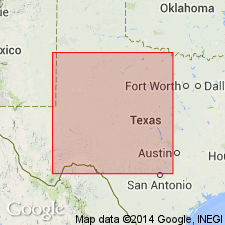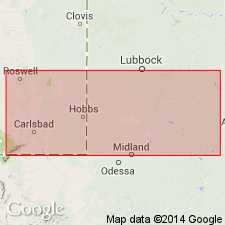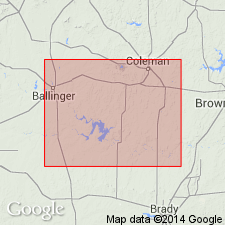
- Usage in publication:
-
- Arroyo formation
- Modifications:
-
- Original reference
- Dominant lithology:
-
- Limestone
- Marl
- Shale
- Gypsum
- AAPG geologic province:
-
- Permian basin
Summary:
Pg. 45-46. The term Arroyo formation is given to series of soft limestones, marls, shales, and gypsum, 260 feet thick in Runnels County, central Texas, which occur on and near Los Arroyo, 2.25 miles west of Ballinger. There is one persistent bed of gypsum in lower part of formation, and some shales are red. It is apparently the same set of rocks to which Wrather [1917] applied Abilene formation in Taylor County, Texas, but that name had already been used for other formations and Arroyo is substituted for it. The correlation of upper part of formation with the limestone at the standpipe at Abilene was substantiated by W.A. Riney. This formation is tentatively placed as top member of Wichita stage. [Age is Permian.]
Source: US geologic names lexicon (USGS Bull. 896, Abilene entry p. 9).

- Usage in publication:
-
- Arroyo formation*
- Modifications:
-
- Overview
- AAPG geologic province:
-
- Bend arch
Summary:
Most geologists (including USGS and Texas Geol. Survey, Sellards, 1933) now [ca. 1938] include Arroyo formation in Clear Fork group, but some geologists have included it in Wichita group. [Age is Permian.]
Source: US geologic names lexicon (USGS Bull. 896, p. 77).

- Usage in publication:
-
- Arroyo formation*
- Modifications:
-
- Areal extent
- AAPG geologic province:
-
- Bend arch
Summary:
Pg. 66 (fig. 1). Arroyo formation. Shown on stratigraphic table as comprising (ascending) Rainey [Rainy], Lytle, and Standpipe limestone members. Underlies Vale formation; overlies Lake Kemp formation. [Age is Permian (Leonard).]
Source: US geologic names lexicon (USGS Bull. 1200, p. 143).

- Usage in publication:
-
- Arroyo formation*
- Modifications:
-
- Areal extent
- AAPG geologic province:
-
- Bend arch
Summary:
Pg. 42. Arroyo formation. Basal formation of Clear Fork group. Underlies Vale formation; overlies Lueders limestone. Thickness about 250 feet. [Age is Permian (Leonard).]
Source: US geologic names lexicon (USGS Bull. 1200, p. 143).

- Usage in publication:
-
- Arroyo formation*
- Modifications:
-
- Areal extent
- AAPG geologic province:
-
- Bend arch
Summary:
Sheet 2. Arroyo formation of Clear Fork group. Shown on composite columnar section of Permian rocks in Colorado River Valley as overlying Lueders limestone.
Source: Publication; US geologic names lexicon (USGS Bull. 1200, p. 143).
For more information, please contact Nancy Stamm, Geologic Names Committee Secretary.
Asterisk (*) indicates published by U.S. Geological Survey authors.
"No current usage" (†) implies that a name has been abandoned or has fallen into disuse. Former usage and, if known, replacement name given in parentheses ( ).
Slash (/) indicates name conflicts with nomenclatural guidelines (CSN, 1933; ACSN, 1961, 1970; NACSN, 1983, 2005, 2021). May be explained within brackets ([ ]).

